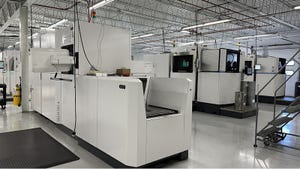July 5, 2001

Monday, April 9, 2001
Chicago-Today's Ethernet promises big benefits across all levels of industrial control. But one major question remains for automation and control engineers. Can standard RJ45 connectors and CAT5 cables, designed for the front office, survive out back on the factory floor?
Fact is, at least three companies don't think so. At least, not when it comes to taking Ethernet components out of the protective confines of the enclosure (IP20 or less), and putting them in the harsh (IP67 or greater), dirt-filled reality of shock, vibration, moisture, and extreme temperature.
That's why in a joint press briefing at National Manufacturing Week last month, Lumberg, Commscope, and Interlink BT announced a ruggedized Industrial Ethernet field-interface solution that's really ready for the plant floor.
The system supports legacy RJ45 connectors within protected environments. However, etherMATE(TM) RJ45-M12 bulkhead receptacles from Lumberg (www.lumbergusa.com) seamlessly convert the RJ45 connectors inside the enclosure to the tried and proven threaded M12 form factor outside of the cabinet.
Connector cordsets and patch cords tie everything together with shielded and braided ICAT5e cable. The new industrial-grade cable was specifically developed by Commscope (www.commscope.com) to handle different combinations of noise and flex that are found in the heavy industrial environment.
To complete the new industrial Ethernet solution, Interlink BT (www.interlinkbt.com) talked about its industrially hardened Ethernet switches, routers, and hubs, and how they will provide completely enclosure-less Ethernet connectivity to reduce cabinet real estate on the machine, decrease maintenance, and simplify installation.
Given Ethernet's momentum today, about the only thing that could stop it dead in its tracks is the sour taste of factory-floor failures in the mouths of automation and control engineers. Radiographic inspections indicate that the RJ45 connector just isn't up to the task of implementing Ethernet on physical field devices, according to Sundar Balu, product manager industrial automation products at Lumberg.
"I have absolutely no faith in the reliability of RJ45 connectors outside of the electrical enclosure," he explains. "The snap-fit design gives no control over the insertion and pullout forces, and its thin contact area is susceptible shock and vibration." In contrast, the M12's threaded housing provides a secure fit, and contact size and material can be easily altered for specific applications.
"M12 offers excellent protection against moisture buildup, dust, corrosion, EMI/RFI, vibrations, and shock," says Balu. "And it doesn't create any new implications for the existing environment where people are already using RJ45 inside of a cabinet."
About the Author(s)
You May Also Like





